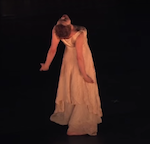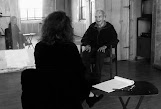originally published in
Ocean (2010)
directed by Charles Atlas/ choreography by Merce Cunningham
THE WHITNEY MUSEUM OF AMERICAN ART | APRIL 11 – 15
| Photo credit: Cameron Wittig. Courtesy of Walker Art Center. |
The dance has since been revived thrice, most recently for a fantastic run in a setting for the Rainbow Granite Quarry in Minnesota, in 2008. There, Charles Atlas, Cunningham’s long time collaborator in filmmaking, captured the dance. Although you can’t see him in the film, the choreographer is there — just off the circle of the stage, near the ramp by which the second dancer in the piece enters, bundled in a winter coat and hat and scarf against the damp and bitter night air.
At the time of that revival, in July 2008, I asked Merce Cunningham about the process of making “Ocean,” in one of 19 interviews for the web series “Mondays with Merce.” Here are excerpts, never before published, from that discussion.
Nancy Dalva: Ocean took its title from Joyce, in a sense.
Merce Cunningham: Yes. I’ve forgotten when, but Joseph Campbell, the mythologist who was a friend of ours [Cunningham and John Cage], was talking once about Joyce, that he thought the next work Joyce would have done would have been about water—Ocean. That’s how it began. And John Cage began putting ideas about it with [the composer] Andrew Culver’s help into the computer. This would be a large work. We had both decided it could be 90 minutes, and we both liked the idea of not...no intermission, because I thought, well, that’s the length of movies and people don’t expect an intermission. So we could begin to think that way. And then there were, again from Joyce, I think it’s Ulysses that has 17 parts. Finnegan—the Wake—has 18. So we assumed that this could be 19. So in my choreographic scheme, I decided there would be 19 sections. That had nothing to do with the length of any given section, except the whole thing would be 90 minutes.
Dalva: How did you determine the length of the individual sections?
Cunningham: A great deal of it came up by chance. For Ocean I first thought to make 64 phrases, but I didn’t think that would be enough, so I made 128. Some of them are very short, some of them are long continuous phrases. Then the order I did again by using chance. So that often the length of the section was determined by how the phrasing came out. If it were a long phrase, it might take three minutes.
Working on Ocean was an absolutely extraordinary adventure. I came here [to the Merce Cunningham Dance Studio at Westbeth] on a Sunday. We were going to begin rehearsal that week. So I came and marked out—here by myself in this large studio—I marked out a circle. Then I thought, well, since I’m not in the circle yet, I—trying this out—would have to start off stage.
What was off stage? So I figured out—well, I’m practical, I put it at the back, and that was an entrance. Then I started the phrase that came into the circle—into the performing area—and stopped—
What’s front? It’s all front. So then I thought, well, if I use chance to determine—having come in—which way you face, how many space changes do you make…? So again, to aid in all this—or I thought it would—I divided this circle into a maximum of 12 possible spaces. Then again by chance I determined whether a phrase would stay in a given space or whether it would move from one to another. And in the course of all that, how many times did it turn, so to speak, front. Front was wherever you face.
Okay, well that you can see took a while, and it took me quite a while to figure out a way to translate this to the dancers because the whole thing was an adventure. But it was so fascinating to me the way something that I had always seen from one angle, now I was seeing it from three or four different angles.
Dalva: After the premiere in Brussels—just after the opening night party—you said to me, “Now all my dances look flat to me.”
Cunningham: Yes. With a proscenium space your focus is mainly front. Even though you can turn this way and that way [gestures with his hands], ordinarily, you see it mainly this way. Maybe this way. Maybe this way. How often do you see it from the back?
Dalva: It’s like trying to get through a canvas on a painting to see the other side.
Cunningham: Yep. But also the chance operation, using it that way made one shift constantly. For instance, the dancers were in one space facing this way. Then the next phrase having gone through the chance operation, you find three of them are going to be over there and one of them is going to be there. But when they get there, which way do they face? So that the thing was not always a reference constantly to one direction, but to this multiplicity of directions.
Dalva: There’s no bad seat in the house for Ocean.
Cunningham: Nobody has ever complained to me that they had a bad seat.
In his editing of the film he captured at the quarry, Charles Atlas has captured not an experience of seeing Ocean a single time, from a single seat, but the experience of seeing it many times, from various points of view; a notion of the work in its entirety. This was a last collaboration, because just as Cage died before the dance could be made, Cunningham died before the film was complete. Like Merce before him, Charles Atlas completed the work begun in tandem: a marvelous, monumental, and infinitely telling ending to their marvelous partnership.
Photo credits: Cameron Wittig. Courtesy of Walker Art Center.
© Nancy Dalva 2008, 2012


















